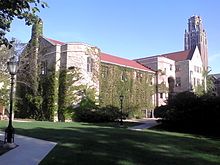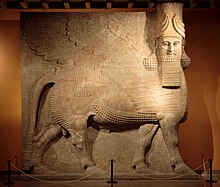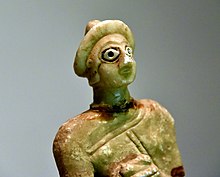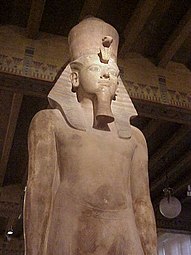 East Meets West tympanum, designed in 1931 by sculptor Ulric Ellerhusen East Meets West tympanum, designed in 1931 by sculptor Ulric Ellerhusen | |
| Established | 1919 |
|---|---|
| Location | University of Chicago 1155 E 58th Street Chicago, Illinois |
| Coordinates | 41°47′22″N 87°35′52″W / 41.78944°N 87.59778°W / 41.78944; -87.59778 |
| Type | Archaeology; languages |
| Website | isac |
The Institute for the Study of Ancient Cultures, West Asia & North Africa (ISAC; formerly the Oriental Institute), established in 1919, is the University of Chicago's interdisciplinary research center for ancient Near Eastern studies and archaeology museum. It was founded for the university by Egyptology and ancient history professor James Henry Breasted with funds donated by John D. Rockefeller Jr. It conducts research on ancient civilizations throughout the Near East, including at its facility, Chicago House, in Luxor, Egypt. The institute also publicly exhibits an extensive collection of artifacts related to ancient civilizations and archaeological discoveries at its on-campus building in Hyde Park, Chicago. According to anthropologist William Parkinson of the Field Museum, the ISAC's highly focused "near Eastern, or southwest Asian and Egyptian" collection is one of the finest in the world.
History

In the early 20th century, James Henry Breasted built up the collection of the university's Haskell Oriental Museum, which he oversaw along with his field work, and teaching duties. He dreamed, however, of establishing a research institute, "a laboratory for the study of the rise and development of civilization," that would trace Western civilization to its roots in the ancient Middle East.
As World War I came toward a close, Breasted sensed an opportunity to use his influence in the new political climate to create opportunities for access to archaeology sites and their study. He wrote to John D. Rockefeller Jr., and proposed the foundation of what would become the Oriental Institute. Fundamental to the implementation of his plan was a research trip through the Middle East, which Breasted had optimistically suggested was ready to receive scholars again after the disturbances of the war. Breasted received a reply from Rockefeller pledging $50,000 over five years for the Oriental Institute. Rockefeller also assured University of Chicago president Harry Pratt Judson that he would pledge another $50,000 to the cause. The University of Chicago contributed additional support, and in May 1919 the Oriental Institute was founded.
The institute is housed in an unusual Art-Deco/Gothic building at the corner of 58th Street and University Avenue, which was designed by the architectural firm Mayers Murray & Phillip.
Construction was completed in 1930, and the building was dedicated in 1931. German American sculptor Ulric Ellerhusen designed the tympanum, titled East Meets West. Figures from the East include a lion, Zoser, Hammurabi, Thutmose III, Ashurbanipal, Darius the Great and Chosroes; the West is portrayed by a bison and Herodotus, Alexander the Great, Julius Caesar, a crusader, an excavator, and an archeologist.
In the 1990s, Tony Wilkinson, founded the 'Center for Ancient Middle Eastern Landscapes' based at the institute. Its role is to investigate the Middle East through landscape archaeology and the analysis of spatial data, including images from many decades of Middle Eastern aerial photography, and survey maps, as well as, modern satellite imagery.
Name change
In the 2010s, multiple organizations within the U.S. began reconsidering the use of the word "Oriental," as some scholars felt the word was alienating and that it had changed in popular meaning. In March 2023, University of Chicago administrators announced they would be changing the name of the Oriental Institute. Interim director Theo van den Hout said, " name has caused confusion, often contributing to the perception that our work is focused on East Asia, rather than West Asia and North Africa. Additionally, the word "oriental" has developed a pejorative connotation in modern English." In April 2023, the organization's name changed to the Institute for the Study of Ancient Cultures, West Asia & North Africa, abbreviated as ISAC. The institute's new logo features a lotus flower, which is found in ancient Assyrian, Mesopotamian, and Egyptian art, as well as being a decorative motif on the ISAC building.
Research and collection



The ISAC Museum has artifacts from digs in Egypt, Israel, Syria, Turkey, Iraq, and Iran. Notable works in the collection include the famous Megiddo Ivories; various treasures from Persepolis, the old Persian capital; a collection of Luristan Bronzes; a colossal 40-ton Lamassu from Khorsabad, the capital of Sargon II; and a monumental statue of King Tutankhamun. The museum has free admission, although visitors are encouraged to donate.
The Institute for the Study of Ancient Cultures, West Asia & North Africa is a center of active research on the ancient Near East. The building's upper floors contain a library, classrooms and faculty offices, and its gift shop, the Suq, also sells textbooks for the university's classes on Near Eastern studies. In addition to carrying out many digs in the Fertile Crescent, institute scholars have made contributions to the understanding of the origins of human civilization. The term "Fertile Crescent" was coined by J. H. Breasted, who popularized the connection of the rise of civilization in the Near East with the development of European culture.
In 2011, among other projects institute scholars completed publication of the 21-volume Chicago Assyrian Dictionary, a basic cultural reference work. The effort was begun in 1921 by J. H. Breasted, and continued by Edward Chiera and Ignace Gelb, with the first volume published in 1956. Erica Reiner as editor-in-charge led the research teams for 44 years. She was succeeded by Martha T. Roth, dean of humanities at the university. Similar dictionaries are under way, including the Chicago Hittite Dictionary and the Chicago Demotic Dictionary.
Chicago House
The Institute oversees the work of Chicago House in Luxor, Egypt. The Egyptian facility, established in 1924, performs the Epigraphic Survey, which documents and researches the historical sites in Luxor. It also manages conservation at various sites.
Persian tablets lawsuit
Further information: Rubin v. Islamic Republic of IranIn 2006, the Oriental Institute was the center of a controversy when a U.S. federal court lawsuit sought to seize and auction a valuable collection of ancient Persian tablets held by the museum. The proceeds were to compensate the victims of a 1997 bombing in Ben Yehuda Street, Jerusalem, an attack which the United States claimed was funded by Iran. The ruling threatened sale of an invaluable collection of ancient clay tablets, held by the Oriental Institute since the 1930s, but owned by Iran. The Achaemenid (or Persepolis) clay tablets were loaned for study to the University of Chicago in 1937. They were uncovered in Persepolis, Iran by American archaeologists from the university in 1933 and are legally the property of the National Museum of Iran and Iran's Ministry of Cultural Heritage, Tourism and Handicrafts. The artifacts were loaned for study based on the understanding that they would be returned to Iran, which the OI had done in batches over the years. The tablets, from Persepolis, the capital of the Achaemenid Empire, date to about 500 BCE.
The tablets give a view of daily life, itemizing such elements as the daily rations of barley given to workers in nearby regions of the empire. The tablets were sent to the capital to provide a record of what they were paying workers. Gil Stein, former director of the Oriental Institute, said that details largely concern food for people on diplomatic or military missions. Each tablet is about half the size of a deck of playing cards and has characters of a dialect of Elamite, an extinct language understood by perhaps a dozen scholars in the world.
Stein described the tablets as providing "the first chance to hear the Persians speaking of their own empire". Charles Jones, Research Associate and Librarian at the Oriental Institute and tablet expert, compared them to "credit card receipts". Most current knowledge about the ancient Persian empire comes from the accounts of others, most famously the Greek storyteller Herodotus. Stein added: "It's valuable because it's a group of tablets, thousands of them from the same archive. It's like the same filing cabinet. They're very, very valuable scientifically." The Oriental Institute had been returning them to Iran in small batches. Since the 1930s, the institute had returned several hundred tablets and fragments to Iran and were preparing another shipment when the legal action began. An appeals court later overturned the order of seizure, and in 2018, the United States Supreme Court affirmed the subsequent ruling that the collection cannot be taken from the Institute to satisfy the judgment.
Directors
List of directors:
- 1919–1935: James Henry Breasted; inaugural director
- 1936–1946: John A. Wilson
- 1950–1960: Carl Hermann Kraeling
- 1962–1968: Robert McCormick Adams Jr.
- 1968–1972: George R. Hughes
- 1972–1981: John A. Brinkman
- 1981–1983: Robert McCormick Adams Jr. (second term)
- 1983–1989: Janet H. Johnson
- 1989–1997: William Marvin Sumner
- 1997–2002: Gene B. Gragg
- 2002–2017: Gil Stein
- 2017–2021: Christopher Woods
- 2021–2023: Theo Van Den Hout (Interim Director)
- 2023–Present: Timothy P. Harrison
See also
Gallery
-
Reconstructed headstone from Persepolis
-
Prehistoric objects
-
Standard weight of the Achaemenid period
-
 Golden winged lion
Golden winged lion
-
 Engraving of a lion on a wall from Persepolis
Engraving of a lion on a wall from Persepolis
-
 A colossal statue of Tutankhamun from ancient Egypt
A colossal statue of Tutankhamun from ancient Egypt
References
- Johnson, Steve (19 September 2019). "The Oriental Institute has a 100th birthday makeover wish — to no longer be Chicago's 'hidden gem'". Chicago Tribune. Retrieved 2019-09-25.
- Breasted, Charles (2010). Pioneer to the past : the story of James Henry Breasted, archaeologist. Chicago: University of Chicago. p. 238. ISBN 9781885923677.
- "The Oriental Institute". University of Chicago. Archived from the original on 11 February 2011. Retrieved 27 May 2013.
- ^ The Oriental Institute of the University of Chicago In commemoration of the dedication of the Oriental Institute building, December fifth, 1931
- Stein, Gil. "Tony Wilkinson Remembrance". News. The American Schools of Oriental Research. Archived from the original on 22 January 2015. Retrieved 22 January 2015.
- "About CAMEL". The Oriental Institute. The University of Chicago. Archived from the original on 22 January 2015. Retrieved 22 January 2015.
- Callaway, Ewen (13 November 2018). "'Oriental' archaeology society reconsiders its name". Nature. doi:10.1038/d41586-018-07396-9. S2CID 165616756. Retrieved 4 April 2023.
- Kolodziej, Charlie (15 March 2023). "The Oriental Institute is changing its name". Hyde Park Herald. Retrieved 18 March 2023.
- Caine, Paul (3 April 2023). "The OI Gets Rebranded, Drops 'Oriental' From Name". WTTW News. Retrieved 4 April 2023.
- "The OI has changed its name to ISAC". YouTube. The Institute for the Study of Ancient Cultures. 4 April 2023. Retrieved 4 April 2023.
- "Oriental Institute". Oi.uchicago.edu. Archived from the original on 22 July 2016. Retrieved 1 August 2016.
- "Oriental Institute | The Epigraphic Survey". Oi.uchicago.edu. Archived from the original on 6 September 2013. Retrieved 12 September 2013.
- ^ Slevin, Peter (2006-07-18). "Iran, U.S. Allied in Protecting Artifacts". Washington Post. p. A03. Archived from the original on 2006-07-21. Retrieved 2006-08-29.
- ^ "University of Chicago returns ancient Persian tablets loaned by Iran". 29 April 2004. Archived from the original on 3 August 2006. Retrieved 27 July 2006.
- ^ Herrmann, Andrew (27 June 2006). "Victims claim win in fight for U. of C. tablets". Chicago Sun-Times. Archived from the original on 2020-06-13. Retrieved 2006-07-27.
- ^ "Iranian Antiquities May Be Seized in Suit". 28 June 2006. Retrieved 27 July 2006.
- "Rubin v. The Islamic Republic of Iran, 637 F.3d 783 (7th Cir. 2011)". Retrieved 2018-04-05.
- "16-534 Rubin v. Islamic Republic of Iran" (PDF). Supreme Court of the United States. Archived (PDF) from the original on 22 February 2018. Retrieved 5 April 2018.
- "Directors of the Oriental Institute". The Oriental Institute. University of Chicago. Archived from the original on 13 April 2018. Retrieved 12 April 2018.
- https://www.facebook.com/OrientalInstitute/photos/a.10151241555369486/10158974002584486/?type=3
- https://isac.uchicago.edu/article/timothy-p-harrison-appointed-director-institute-study-ancient-cultures
External links
- Official website
- The Oriental Institute in Google Cultural Institute
- Abzu, a guide to open access material of the Ancient Near East
- A database on the Oriental Institute's website maintained by Clemens Reichel documenting artifacts stolen from the Iraq Museum in April 2003
- Persepolis Fortification Archive Project
- The Oriental Institute: Fragments for a History of an Institution, collaborative project intended to focus ideas and thoughts on the history of the Oriental Institute of The University of Chicago
| Museums in Chicago | |
|---|---|
| Art |
|
| Architecture | |
| Children | |
| Culture |
|
| History | |
| Science | |
| Planned | |
| Former | |
- 1919 establishments in Illinois
- Ancient Near East organizations
- Archaeological museums in Illinois
- Art museums and galleries in Chicago
- Egyptological collections in the United States
- Hyde Park, Chicago
- Museums established in 1919
- Museums of the ancient Near East in the United States
- Oriental studies
- University museums in Illinois
- University of Chicago
- Research institutes of the University of Chicago
- Museums in Chicago
- Academic and educational organizations in Chicago